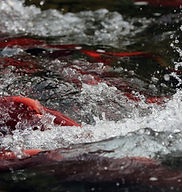Threats to Water and Subsistence Resources in Northern Alaska
- halshepherdwpc
- Sep 11
- 4 min read
Updated: Sep 19
Alaska’s Public Lands at Risk: What You Need to Know

The Central Yukon Resource Management Plan (CYRMP)
BLM lands in the Central Yukon region encompass some of the most pristine, undeveloped public lands in the nation, including portions of the nation’s third-longest river (the Yukon River), crucial spawning habitat for sheefish and chinook salmon, and high-value wildlife habitat for three caribou herds, Dall Sheep, musk oxen, and hundreds of migratory birds.
These federal public lands also serve as a vital carbon sink. A 2018 USGS study determined that the amount of carbon stored on federal lands in Alaska was approximately 62 percent of the total carbon stored on all federal lands in the U.S. Thus, broad conservation measures within the 2 CYRMP are essential to tackle the climate crisis and put America on the path to protect of these lands by 2030.
The lands in question were previously protected under Public Land Orders (PLO) 5150 and 5180, and D-1 withdrawals under the 1971 Alaska Native Claims Settlement Act (ANCSA)which have kept the area under federal management, safeguarding it from unchecked development. The 2024 Central Yukon Resource Management Plan (CYRMP) is a comprehensive blueprint for managing over 13 million acres of public land including the Gates of the Arctic National Park, Arctic National Wildlife Refuge, Yukon River and Dalton Highway corridor, Denali National Park and Presereve. The CYRMP also provides broad conservation measures that are essential to tackle the climate crisis and puts America on the path to protect these lands by 2030.
Now, in an unprecedented move to overturn the plan through the Congressional Review Act (CRA), with the full support of Alaska Senator Lisa Murkowski, Representative Nick Begich and Senator Dan Sullivan have introduced legislation that would open the door for Industrial development and mineral extraction, eliminate federal subsistence priority protections and increased threats to aquatic habitat and subsistence resources but Using the CRA to disapprove a resource management plan would create significant uncertainty for existing plans across the county.
In addition, applying the CRA to resources management plans would undermined the existing process to amend such plans, dictated by the Federal Land Policy and Management Act (FLPMA) and court out the opportunities for Tribal and public engagement included in those processes; would put back in place three plans that are over three decades old and prohibit the BLM from issuing a "substantially similar" plan in the future regardless of changing needs or conditions.
Finally, using the CRA undermines existing processes to amend resource management plans and cuts out the opportunities for Tribal and public engagement included in the agency's existing processes, and makes it easier to permit the Ambler mining road which has been a flashpoint in Alaska’s land use debates. The Road is a proposed transportation corridor that would cut a 211-mile swath through the pristine Brooks Range foothills and traverse the Gates of the Arctic National Park, one of the largest roadless areas in the country, to access the Ambler Mining District for the alleged purpose of mineral extraction of copper, cobalt, zinc, lead and other minerals. From the Dalton Highway, the road would cross 11 major rivers (including the Koyukuk, Kobuk, and Yukon watersheds) and more than 3,000 freshwater streams. If approved, the road would pose a grave threat to the delicate ecosystems, subsistence ways of life, and cultural heritage to Alaska Native communities.
In 2024, BLM issued a Record of Decision halting the project, citing serious concerns over:
• Harm to fragile ecosystems
• Disruption of the Western Arctic caribou herd
• Loss of subsistence access for rural communities
More than 80% of public comments during the 2023 review period opposed the road—yet despite public opinion about the need to protect public lands, Congress is moving to push through the road and revoke other protections in the YRCRMP under the CRA. Rep. Sarah Elfreth noted, “Congress has never used the Congressional Review Act to overturn a resource management plan or any other similar land use plan in our history.”
⚠️ Why This Matters
If these efforts succeed, Alaska could lose:
• Federal protections for rural subsistence
• Public input in future land management decisions
• Safeguards against industrial development in ecologically sensitive areas
This isn’t just about one planning area—it’s about the future of Alaska’s public lands, wildlife, and communities.
📣 What You Can Do
E-mail the following congressional staff:
Let them know that S.J. Res. 63 ignores the substantial time and collaboration Alaskan Native and other community members put into planning for and developing the Central Yukon Resource Management Plan. Please honor that effort and reject S.J. Res 63. Ask that the Joint Resolution not proceed in the Senate and attach the letter outlining opposition from Alaskans.
For more information:
Fact sheet on the YRCRMP
Map of the YRCRMP








Comments